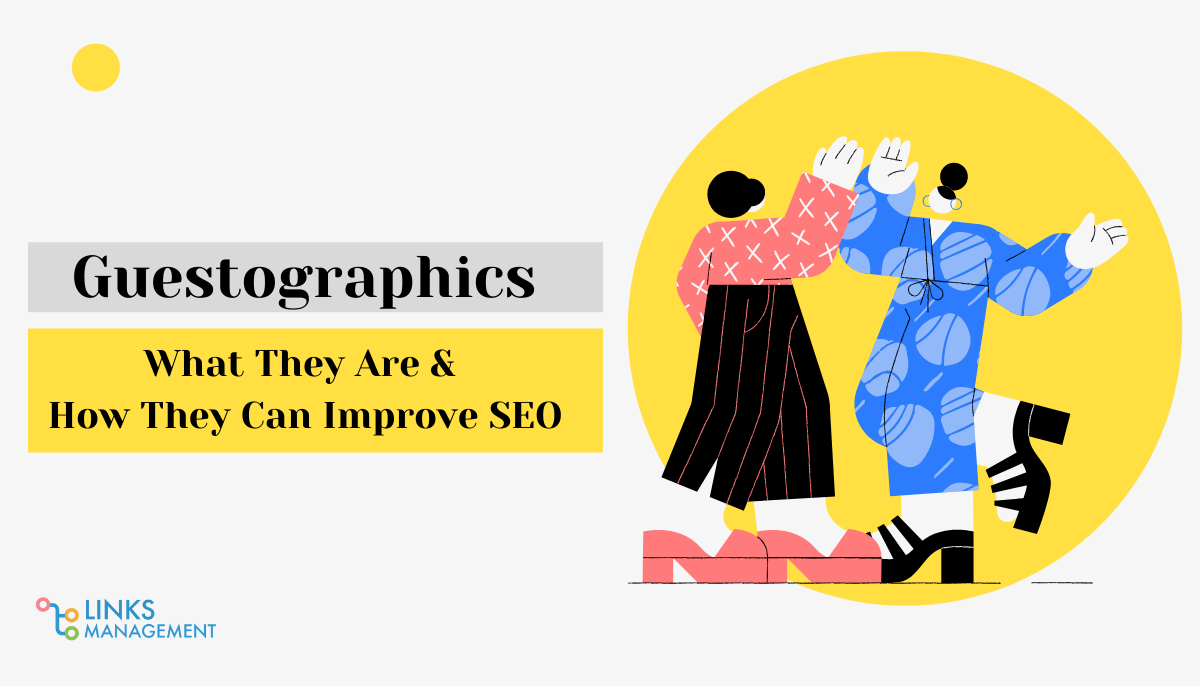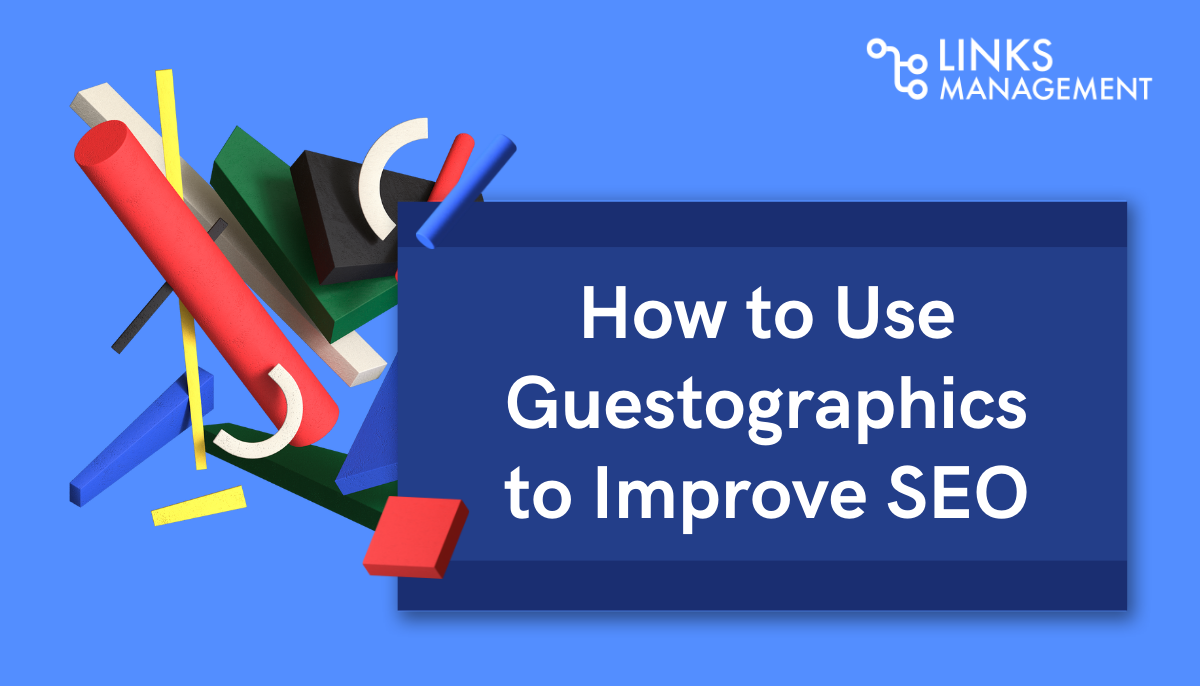Guestographics: What They Are & How They Can Improve SEO
Link building and SEO are closely connected. You can improve one with the other and vice versa. You can write optimized guest posts and insert a backlink there. Or you can optimize your own content and get those mentions naturally from other credible sources.

Every specialist knows this correlation. There are so many materials that sometimes it seems that every website in existence has used this approach at least once. But what’s new? Shouldn’t there be an upgrade already? The online world is evolving every year, so there should be something new in the guest-posting-link-building-SEO niche.
Actually, there’s an approach gaining a new wave of popularity – designing guestographics. It’s not a new technique but it’s getting a lot of attention nowadays. What are they and how can they improve SEO?
We’ll review this topic in the article below.
What Is a Guestographic?
“What is guestographics?” It’s the art of turning information from the website you want to get a backlink from into an infographic. This is a very special type of cooperation where you both get benefits. Guestographics improve SEO metrics for the parties working on the project. You have a chance to partner with sources much higher up in the ranking, improve networking, and establish authority.
If you need a speedy jump to the next level, create several infographics for your own posts and offer the same service to major websites in your niche. A portion of their vast audience will definitely visit your site and find it useful.
This is a wonderful way to diversify your SEO and link-building strategies. Outreaching with such an offer will showcase your creative approach towards every possible reference to your content or skills.
Benefits of Guestographics or Why Use Them?
This technique isn’t new but certainly overlooked. This is an advantage by itself. But there’s more:
Easy promotion for your brand, website, blog, company, etc.
- Well, a relatively easy one, at least. You’ll need to put time and effort into it, but the results will grow your credibility exponentially. Say, there’s one reliable source you work with on the guestographic. It will become popular among the readers and other sources that will link to your partner. As a result, you’ll see considerable growth in backlink quantity.
Not many marketers are using this approach.
- It’s difficult to be original in a field with millions of websites, all wanting the same thing – backlinks. You’ll definitely be the first representative to offer such collaboration for at least ⅓ of link prospects.
People love visuals.
- Guestographics make it easier to derive key takeaways and perceive information. Visuals can contain brand colors, which will increase awareness. This type of content is generally more attractive, both to readers and other bloggers that may want to link to it.
Collaboration opportunities.
- You can get a chance to work with some of the leading websites in your niche. This opens a lot of doors and may save you a ton of time, money, and promotional effort. A showcase to millions of people potentially interested in what you offer is what most beginners and professionals alike dream of.
You achieve native advertising.
- Native advertising is an important benchmark for all brands that follow trends and want to naturally get a lot of traffic. The times of aggressive marketing are long gone. Now, if you want attention, it’s better to be mentioned as a co-author, expert, recommended article, website, blog, etc. Guestographics achieve that in an original way.
The list can go on and on.
How to Use Guestographics to Improve SEO
“How to improve SEO with guestographics?” Let’s say you have a landing page that needs promotion but not many websites agree to link to it. Why? Because it’s not a useful blog post or a video tutorial. It’s a page talking about your brand, products, and/or services. It’s understandable, so don’t be offended.

Instead, offer them an infographic with their information well-formatted and inserted in a gorgeous design. Then, ask to include a link to the landing page as a credit.
The result: you’re happy with a credible backlink to the landing page. The other party is happy with their content being widely distributed online as an infographic. Google doesn’t find anything suspicious and raises both of the pages in rankings for their focus keywords.
Win-win!
But how to use guestographics to improve SEO? Of course, we have a set of recommendations.
1. Analyze and Adjust Your Target Audience
First of all, remember why you’re doing it. The goal isn’t building links. It’s not improving SEO either. It’s not even about rising in SERPs. You want more customers, readers, etc. Focusing on this goal, define your target audience.
To have the closest match possible, create a target profile. This is a set of features of your ideal customers. And it’s pretty easy to get – analyze the existing customer base:
- Who are the most active ones?
- Where do people come from?
- Who are your content, products, or services for?
If the data you have isn’t sufficient, create a survey and ask your email subscribers and website visitors to fill it. Don’t make it too complicated, and more people will answer. Look for a couple of profiles, don’t limit your brand to one type of customer.
This info will help you pitch to the websites that will bring the most value.
2. Target the Right Keywords
In order to improve SEO, you need proper keywords. Review the list if you have one and consider adjusting it if necessary:
- Use Google Keyword Planner to see the potential main and secondary KWs and choose from the needed low- to medium-competition range;
- Use Google Search; just start typing keywords and phrases and see what options the search engine offers.
This will help you find the right type of content to interact with. Pay attention to the topical similarity of your website and a link prospect. You may find an amazing site about flowers, but if you’re trying to promote a blog about link building, this isn’t a perfect match, to say the least.
Why are keywords important for images? Many people forget that alt-tags are also a factor impacting website SEO. Writing proper tags and matching them with the name of the file increases your chances of ranking for that target keyword.
Is it possible to Make Newsworthy Content to Attract Links? Read how to do it here.
3. Look for Proper Content for a Guestographic
Want to know how to generate backlinks fast? Look for the right content to insert them in.
We’ve talked about topic relevance already. But what about the type of article? Not every kind is suitable for a neat guestographic. For example, if you want to create one for a large guide on becoming an SEO specialist, it will be:
- Too labor-intensive for a free-of-charge job;
- It may take too long to load;
- It may just be too long.
If it’s for your own article on a page you want to attract lots of visitors to, OK. But as a collaboration? Maybe you should find something simpler.
The best type of content for a guestographic is a list post, like “X skills needed to be a good SEO expert”. A similar topic, yet an easier format. There’s no need for a hefty infographic. It’s short, well-designed, with clear points.
Plus, there are lots of templates for such visuals, which will make the job cheap if you work with an agency or designer and easy if you try to do everything yourself.
How to find such publications? Use Google Search. Write “10 tips to/10 recommendations for/etc.” and a relevant topic. If you want to go deeper, using tools by SEMRush and Ahrefs may help.
4. Pitch the Infographic Properly
Now, it’s time for the pitch. This part must be concise and perfect because content editors and bloggers get lots of emails every day. They aren’t likely to read through large, vague messages.

So, here’s what you need in the pitch:
- Stating who you are and what you represent;
- Stating what you offer (emphasize that it’s a guestographic, not a regular guest post collab);
- Pitching the value for the other party;
- Asking for a backlink or anything else in return.
If possible, feature past guestographics. Have you collaborated with large platforms before? A name drop would help. But if it’s your first pitch, include anything else that shows your authority and credibility.
Proofread the email and send it.
If You Get a Response
Start your collaboration by asking for all the needed information beforehand, including:
- The header(s);
- The points that will be covered;
- Preference as to form or color;
- Brand design if any, logo, font, etc.;
- CTA (call to action) if any.
To avoid misunderstandings, send them a draft so that you’re on the same page design-wise. Ask for as much info as necessary and make the first draft decent. This will help to prevent everlasting email chains with edits and proofreads.
If You Don’t Get a Response
In case there’s no answer, say, 2-3 days later, send a follow-up, featuring some points on why your collab is going to be a success. You can do it about 3 times. If there’s no reply by that time, they possibly don’t need a guestographic at the moment. There are cases when bloggers would respond after several months when they need something fresh. Then, it’s your decision whether to cooperate with such a late responder.
5. Promote the Resulting Guestographic
You’ve done a huge job. Now, there’s a great collaboration you can share in the next pitch, a backlink, and (hopefully) a better SEO situation in the future. Can this get any better? Yes, it can.
The website you’ve partnered with will definitely promote the infographic. It’s a very important element that can draw thousands of people, with a part of them becoming regular readers and leads.
You should do the same, and here’s how:
- Write a piece for your website, announcing the partnership and leaving feedback. This will establish that you can make guestographics and promote the content that promotes you (twisted but effective);
- Share the post on social media, writing a little about the collaboration there as well. Ask people whether they like it. Create more precise surveys that will show whether this is a working strategy for you. Use the results later on in your pitches;
- Find websites that would be interested in sharing the post with your visuals. Some may ask for the same service, which means more opportunities for you.
How to Measure Google’s E-A-T Criteria and Improve Your Organic Results? Click here to read more and get the answers to the possible questions.
6. Research Unlinked Mentions and Ask for a Backlink
As you ‘launch’ the guestographic, many more websites may consider it useful and feature as a part of their articles. It’s very important that they post a backlink as a source credit, especially if your topics are related.
Some bloggers forget to insert a link or don’t do it on purpose. You can prevent such situations from happening by simply contacting them. But how to track every mention?
You can use Google Alerts. Set an alert on a certain event, like a mention of industry-specific words, your alt-tags, domain, donor site, etc. Not every notification will bring you a credible backlink. But it’s possible to acquire a handful of them in the long run. All that thanks to one guestographic!
Who knows, maybe more bloggers will be interested in such visuals, which may:
- Open a chest of backlink possibilities for any part of your website, even if it’s a landing or a conversion page;
- Drive a business opportunity, allowing for skill monetization (if needed).
To Conclude
Guestographics can greatly help you improve SEO and achieve the final goal faster. The goal can be the first place in SERPs, more traffic, more conversions, a better backlink profile, etc. All of them are, actually, also connected.
Remember the key points of using guestographics to improve optimization:
- Find credible websites to cooperate with;
- Negotiate the best terms;
- Choose proper keywords for the infographic;
- Choose proper content that will represent both sites’ philosophy and tone;
- Make the visual memorable;
- Make the information easy to read and understand;
- Make sure it’s mentioned with a credit on other websites.
A high-quality infographic will earn you a lot of backlinks. The results will be faster than if you would write a guest post for every website the visual is used on. Although guest posting is still the queen of link-building, an additional visual content approach won’t fail you.
Every new credible backlink will make you closer to becoming one of the best in the niche. You will also receive more attention since many people interested in the topic will become curious about your website and what else you can offer aside from an engaging infographic.
Use custom designs wisely and monitor the results!
Enter URL & See What We Can Do Submit the form to get a detailed report, based on the comprehensive seo analysis.